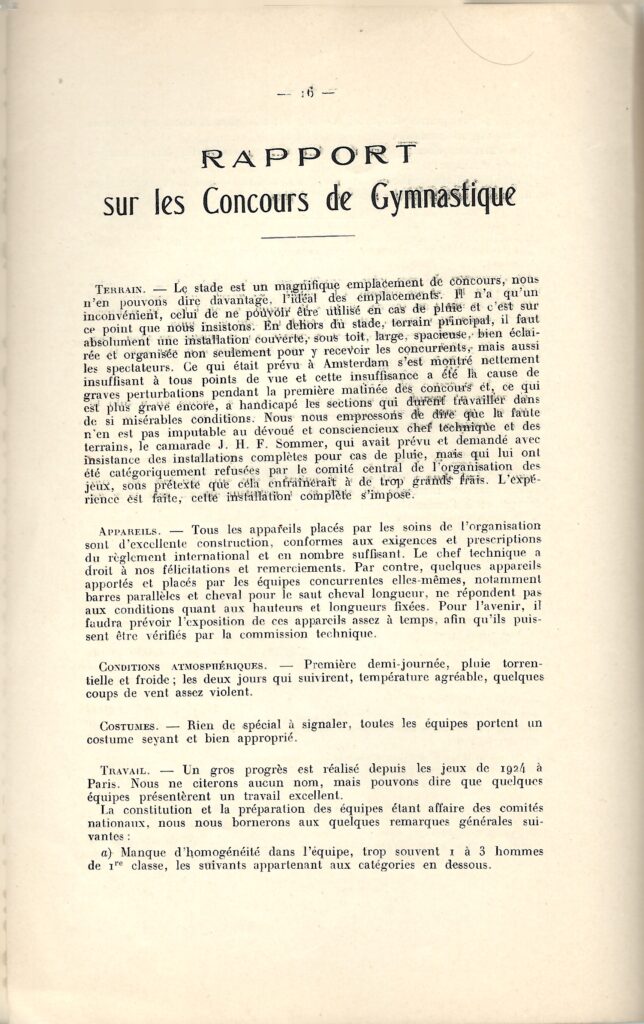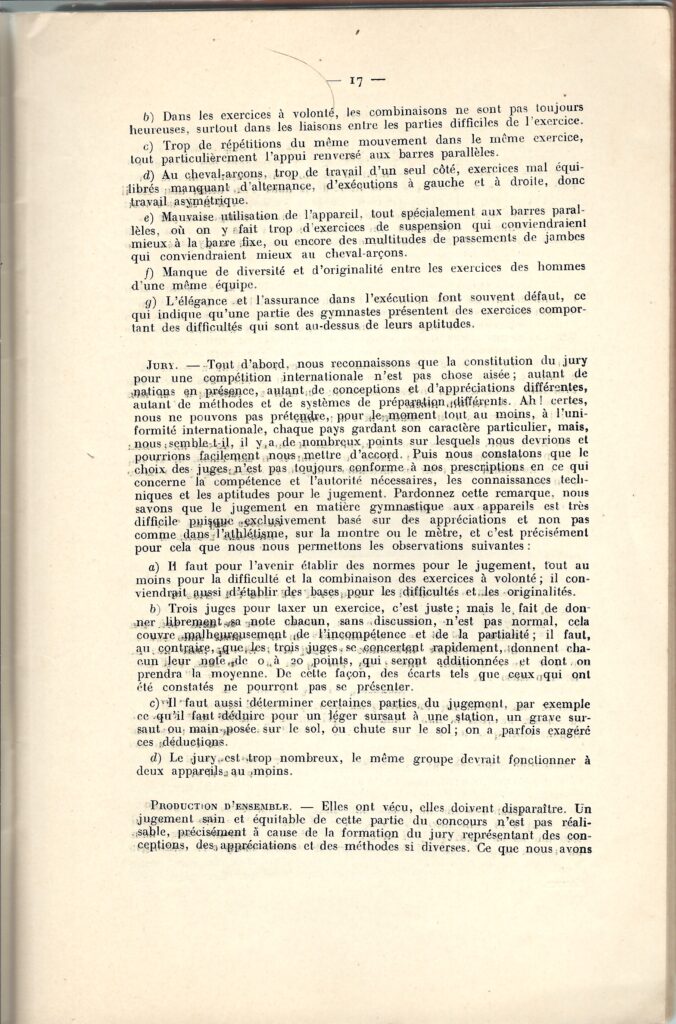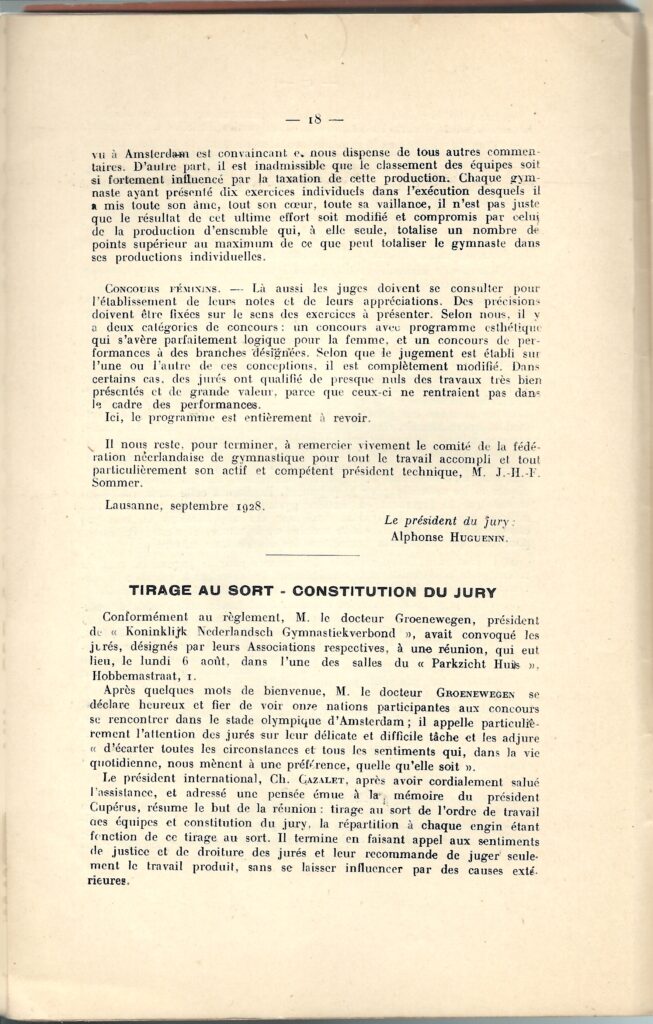Separate from the organizing committee’s Official Report on the 1928 Olympics, the FIG published its own booklet on the gymnastics competition in Amsterdam. What follows is a translation of the report, as well as every score from every judge at the competition — both men’s and women’s.
As you’ll see by the amount of space dedicated to women’s gymnastics in the report, the FIG remained focused primarily on men’s gymnastics.
Let’s dive in.
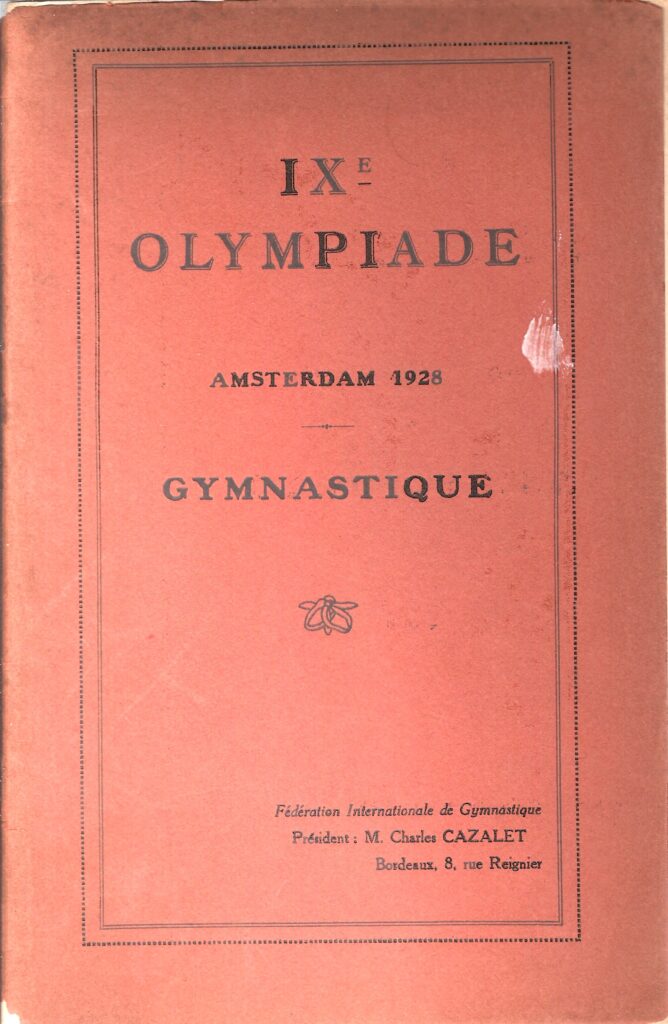
The FIG Report | Every Score from Every Men’s Judge | Every Score from Every Women’s Judge
Elsewhere: The Rules for the Women’s Competition at the 1928 Olympics | Women Compete at the Olympics for the First Time | The Rules for the Men’s Competition at the 1928 Olympics | A Costly Math Error during the Men’s Competition
Report on the Gymnastics Competitions
THE GROUNDS. — The stadium is a magnificent competition location, we cannot say more, the ideal location. It has only one drawback, that of not being able to be used in the event of rain, and it is on this point that we insist. Outside the stadium, the main grounds, it is absolutely necessary to have a covered installation, under a roof, wide, spacious, well lit, and organized not only to receive the competitors, but also the spectators. What was planned in Amsterdam proved to be clearly insufficient from all points of view and this inadequacy was the cause of serious disturbances during the first morning of the competitions and, what is even more serious, handicapped the teams which had to work in such miserable conditions. We hasten to say that the fault lies not with the devoted and conscientious Chief Technical and Grounds Officer, Comrade J. H. F. Sommer, who had planned and insistently requested full rain facilities but were emphatically refused by the central committee for the organization of the games, on the pretext that this would entail excessive expense. The experiment is done; this complete installation is essential.
Reminder: The men’s competition had to be moved into a tent on the first day.
APPARATUS. — All the apparatus placed by the organization are of excellent construction, comply with the requirements and prescriptions of the international regulations, and are in sufficient number. The technical manager is entitled to our congratulations and thanks. On the other hand, some apparatus brought and placed by the competing teams themselves, in particular, parallel bars and horses for the long horse vault, do not meet the conditions as to the fixed heights and lengths. In the future, it will be necessary to present these apparatus sufficiently in advance, so that the technical committee can check them.
ATMOSPHERIC CONDITIONS. — First half-day, torrential and cold rain; the two days that followed, pleasant temperature, a few rather violent gusts of wind.
ATTIRE. — Nothing special to report, all the teams are wearing becoming and appropriate attire.
ROUTINES. — Considerable progress has been made since the 1924 Games in Paris. We won’t mention any names but can say that a few teams presented excellent work.
The make-up and preparation of the teams being a matter for the national committees, we will confine ourselves to the following general remarks:
a) Lack of homogeneity in the team, too often 1 to 3 men of 1st class, the others belonging to the categories below.
b) In the optional exercises, the combinations are not always successful, especially in the connections between the difficult parts of the exercise.
c) Too many repetitions of the same movement in the same exercise, especially the handstand on the parallel bars.
d) On pommel horse, too much work on one side, poorly balanced exercises lacking alternation, left and right moves, therefore asymmetrical work.
e) Improper use of the apparatus, especially on parallel bars, where too many hanging exercises are done which would be better suited to the high bar, or even a multitude of traveling skills which would be better suited to the pommel horse.
f) Lack of diversity and originality between the exercises of the men of the same team.
g) Elegance and assurance in execution are often lacking, which indicates that some of the gymnasts present exercises with difficulties that are beyond their abilities.
JURY. — First of all, we recognize that assembling the jury for an international competition is not easy; so many nations present, so many different conceptions, and appreciations. Ah! Of course, we cannot claim, for the moment at least, international uniformity, each country keeping its particular character, but, it seems to us, that there are many points on which we should and can easily agree. Then we note that the choice of judges does not always conform to our requirements with regard to the necessary competence and authority, technical knowledge, and aptitude for judgment. Pardon this remark, we know that judging in gymnastics with apparatus is very difficult since it is exclusively based on appreciation and not, as in athletics, on the clock or the meter, and that is precisely why we allow ourselves the following observations:
a) It is necessary for the future to establish standards for judging, at least for the difficulty and the combination of the optional exercises; it would also be appropriate to establish bases for difficulties and originalities.
b) Three judges to score an exercise, that’s right; but the fact of giving each person their score freely, without discussion, is not normal, it, unfortunately, hides incompetence and partiality; it is necessary, on the contrary, that the three judges consult each other quickly, each giving their score from 0 to 20 points, which will be added and averaged. In this way, deviations such as those that have been observed cannot arise.
c) Some parts of the judgment also need to be determined, such as what to deduct for a slight hop upon landing, a severe hop or hand on the floor, or a fall on the floor; these deductions have sometimes been exaggerated.
d) The jury is too large, the same group should work with at least two apparatus.
ENSEMBLE ROUTINES. — They lived, they must disappear. A sound and fair judgment of this part of the competition is not feasible, precisely because of the formation of the jury representing such diverse conceptions, appreciations, and methods. What we saw in Amsterdam is convincing and exempts us from any further comments. On the other hand, it is inadmissible that the classification of the teams is so strongly influenced by the scoring of this routine. Each gymnast having presented ten individual exercises in the execution of which he put all his soul, all his heart, all his bravery, it is not right that the result of this ultimate effort be modified and compromised by that of the ensemble performance, which, on its own, totals a number of points greater than the maximum that the gymnast can total in his individual routines.
WOMEN’S COMPETITIONS. — There too the judges must consult each other to establish their scores and their assessments. Details must be fixed on the meaning of the exercises to be presented. In our opinion, there are two categories of contests: a contest with an aesthetic program that makes perfect sense for women, and a performance contest in designated disciplines. According to whether the judgment is established on one or the other of these conceptions, it is completely modified. In some cases, jurors have called very well-presented and valuable work almost void because it did not fit within the performance framework.
Here, the program is to be entirely reviewed.
Finally, it remains for us to warmly thank the committee of the Dutch gymnastics federation for all the work accomplished and especially its active and competent technical president, Mr. J. H. F. Sommer.
President of the Jury:
Alphonse Huguenin
Every Score from Every Judge during the Men’s Competition
Here were the judges for each portion of the competition. (You have to match the roman numerals to the columns in the tables below.)
Pommel Horse (Compulsory):
I. R. J. C. Blom (Netherlands)
II. Comm. Kustaa E. Levälahti (Finland)
III. Pierre Hentges (Luxembourg)
Pommel Horse (Optionals):
I. Jules Klein (France)
II. John Thorin (Switzerland)
III. Aldo Boiti (Italy)
Rings (Compulsory):
I. Cecil E. Matthews (Great Britain)
II. Josip Smertnik (Yugoslavia)
III. Dr. François Fuszfas (Hungary)
Rings (Optionals)
I. Vladimír Müller (Czechoslovakia)
II. Henry Panzer (United States)
III. E. De Wilde (Netherlands)
High Bar (Compulsories)
I. Väinö Teivalaa (Finland)
II. Jean-Pierre Thommes (Luxembourg)
III. Jules Piesvaux (France)
High Bar (Optionals)
I. Armin Lerch (Switzerland)
II. Enrico Genesio (Italy)
III. Alfred Spencer (Great Britain)
Parallel Bars (Compulsories)
I. Stane Vidmar (Yugoslavia)
II. Dr. François Fuszfas (Hungary)
III. Rudolf Bílek (Czechoslovakia)
Parallel Bars (Optionals)
I. Jos. Oszy (United States)
II. L. A. Reilingh (Netherlands)
III. Comm. Väinö E. Tiiri (Finland)
Vault (Compulsories)
I. Charles Quaino (Luxembourg)
II. Jules Piesvaux (France)
III. Carl Vaterlaus (Switzerland)
Vault (Optionals)
I. Angelo Ronzoni (Italy)
II. Arthur G. Mears (Great Britain)
III. Peter Šumi (Yugoslavia)
Ensemble Exercises
I. Bohumil Havel (Czechoslovkia) – Individual Execution
II. Martin H. Trieb (United States) – Individual Execution
III. Dr. François Fuszfas (Hungary) – Combination and Difficulty
IV. L. A. Reilingh (Netherlands) – Combination and Difficulty
V. Comm. Kustaa E. Levälahti (Finland) – Ensemble Execution
The Netherlands
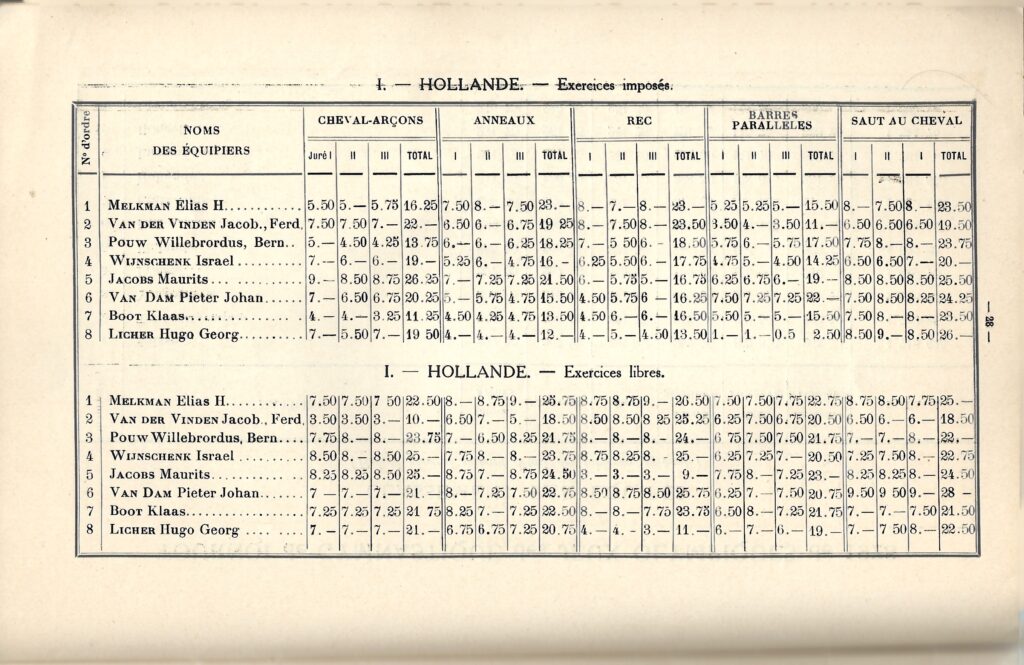
Exercices imposés = Compulsory exercises
Exercices libres = Optional exercises
Cheval-arçons = Pommel horse
Anneaux = Rings
Rec = High Bar
Barres parallèles = Parallel bars
Saut au cheval = Vault
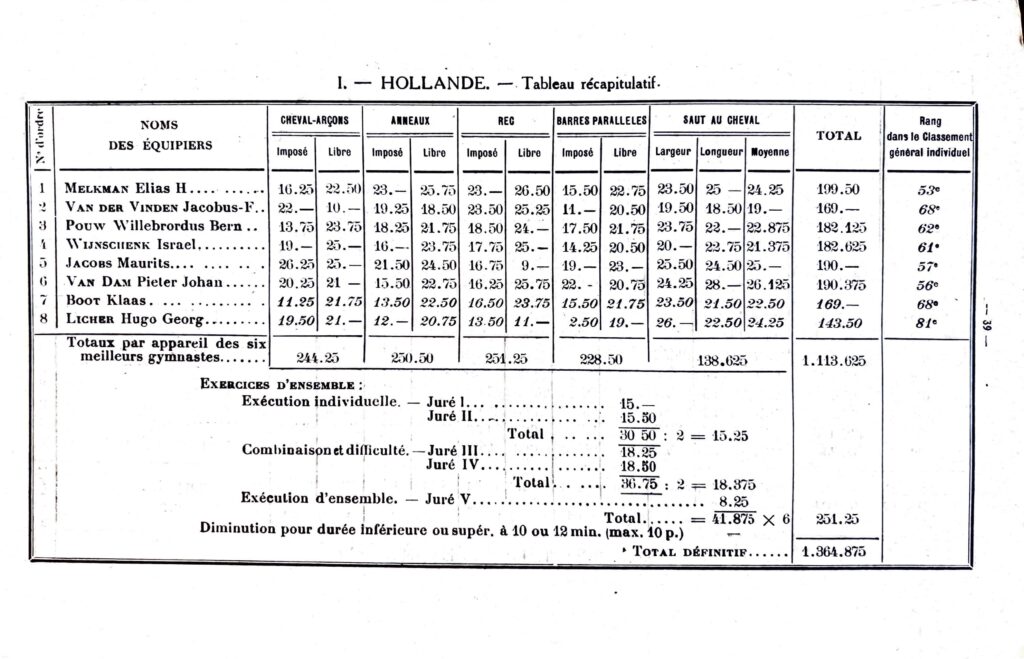
Finland
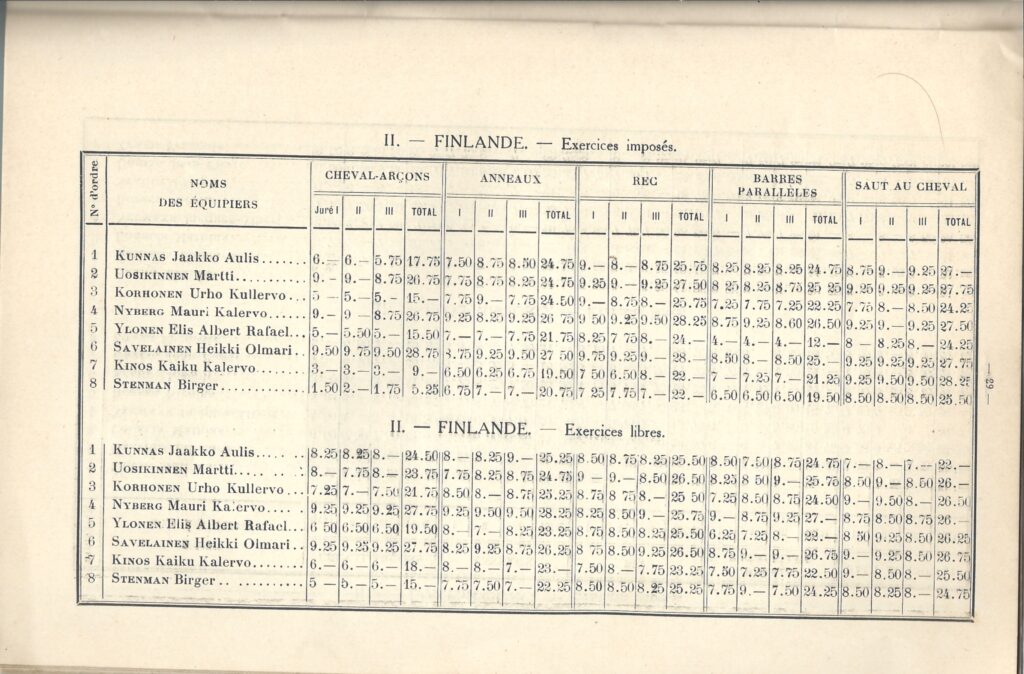
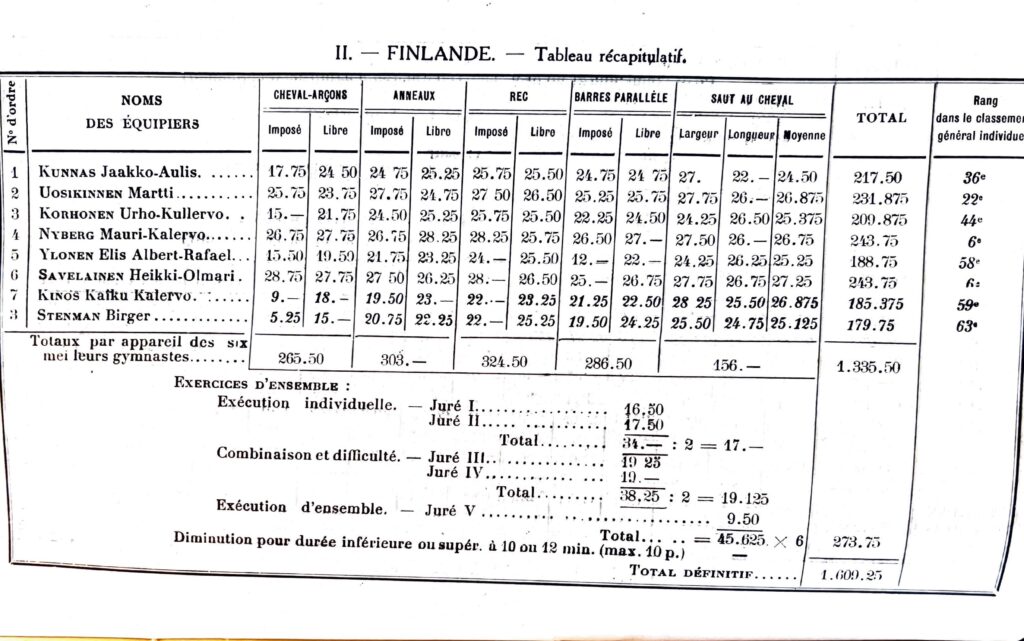
Luxembourg
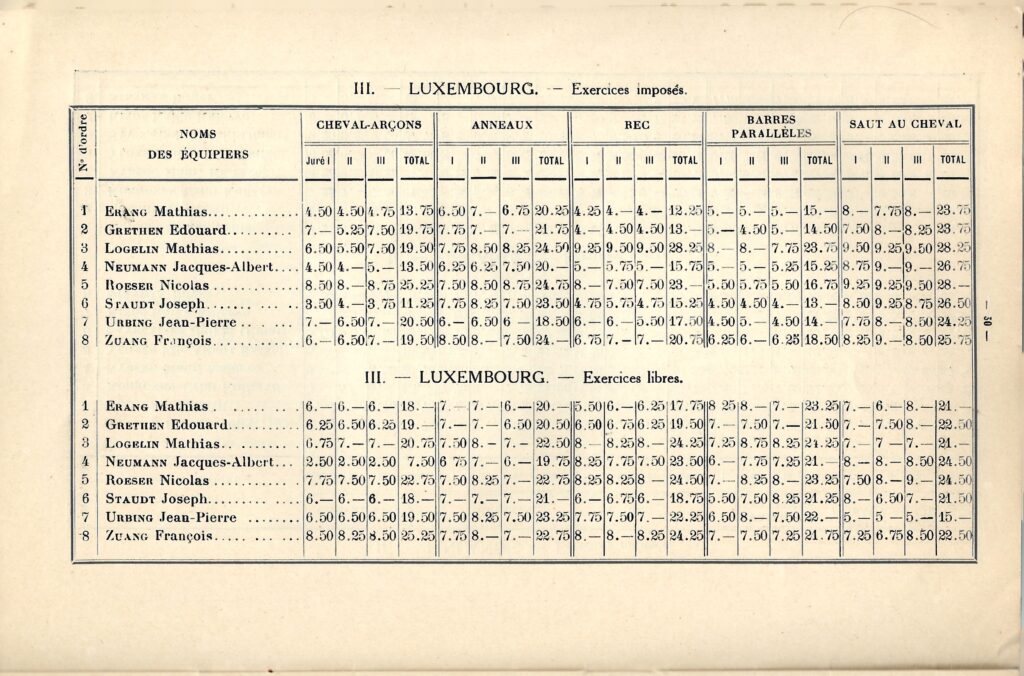
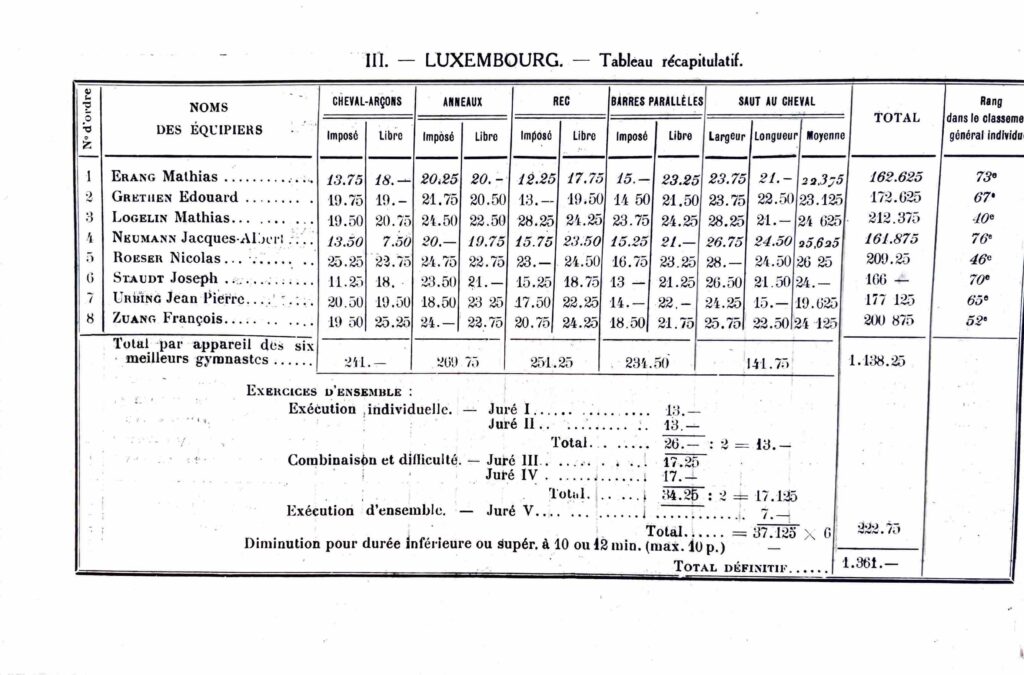
France
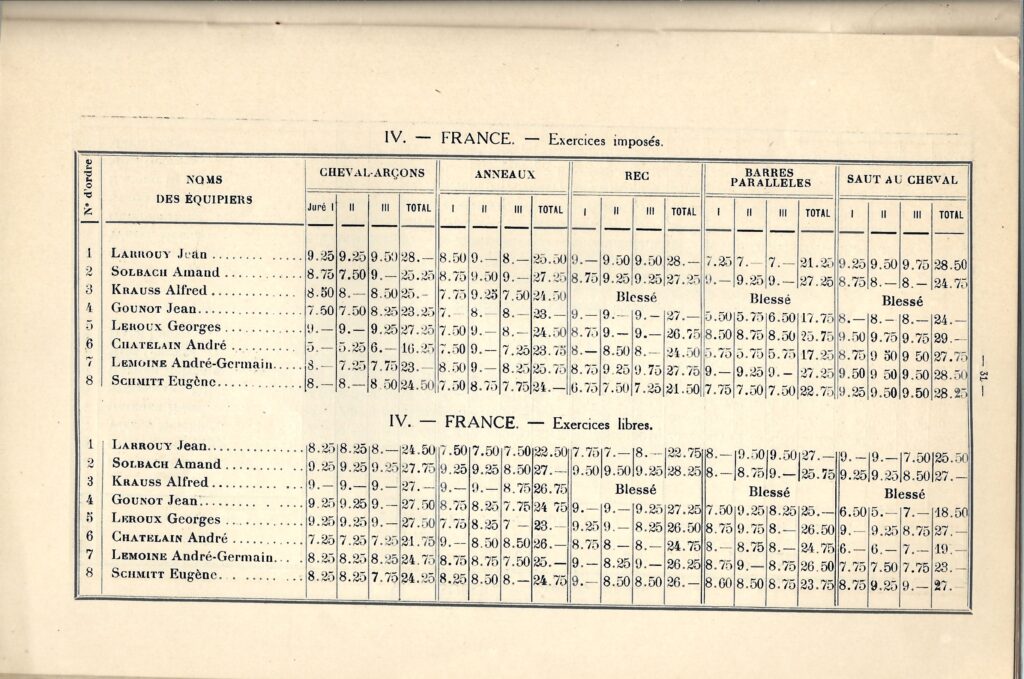
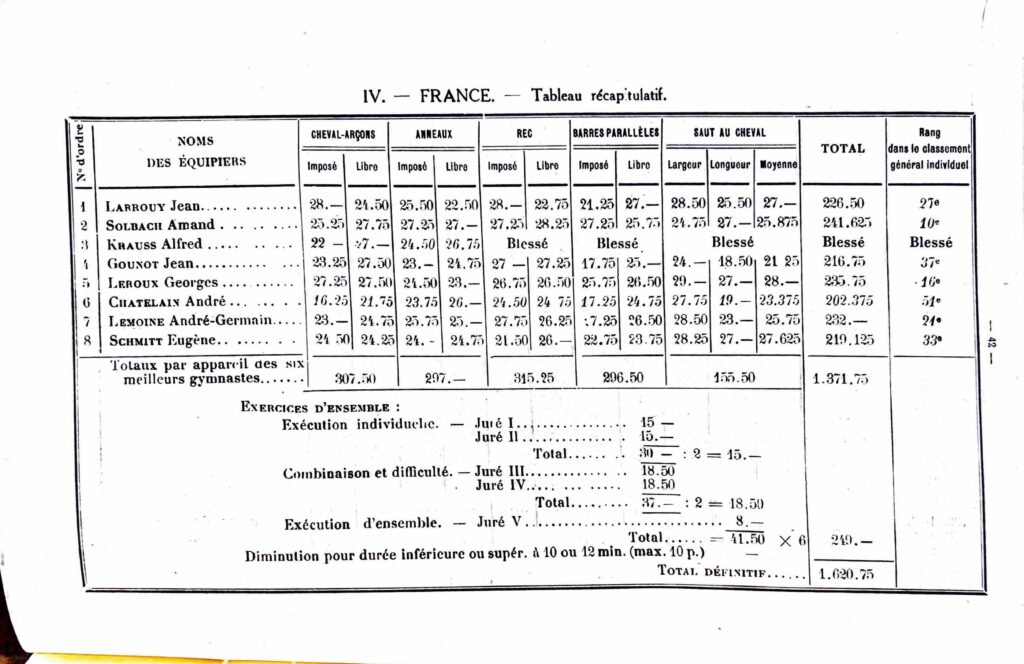
Switzerland
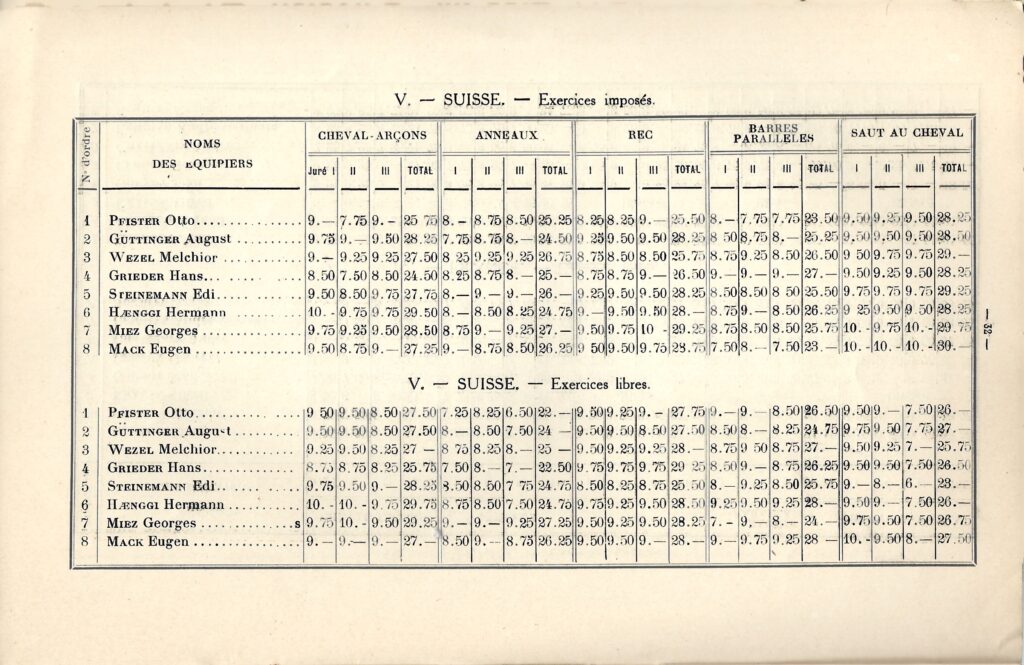
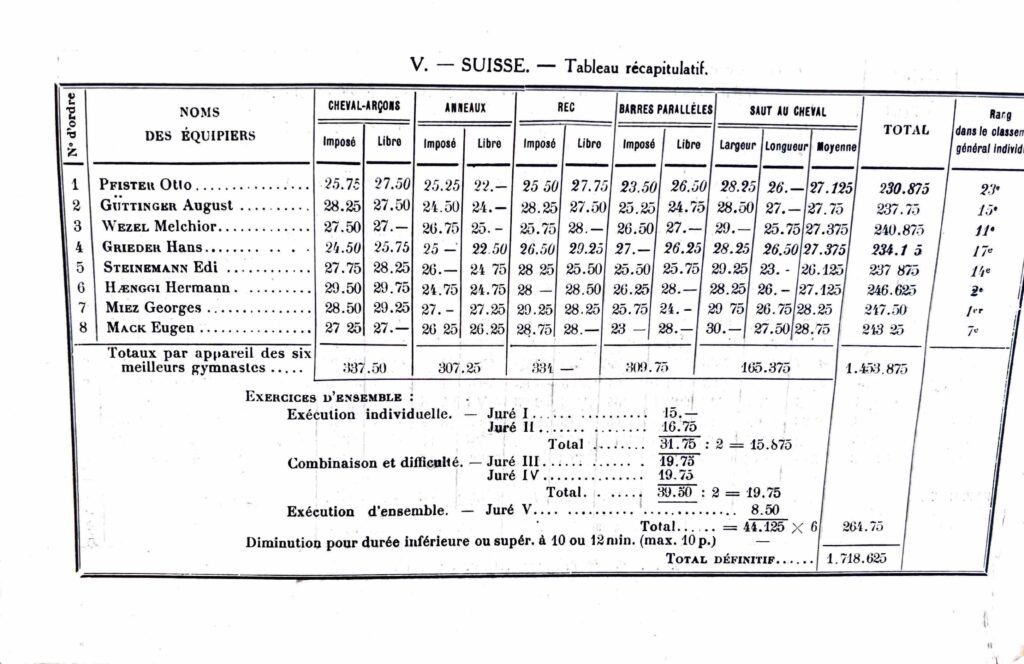
Italy
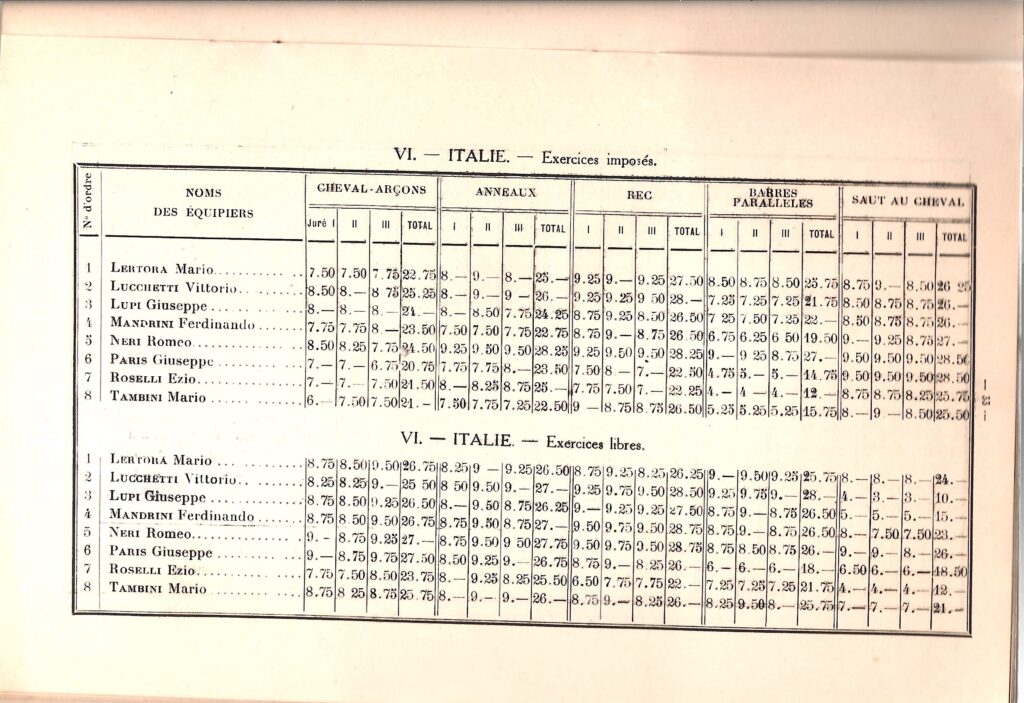
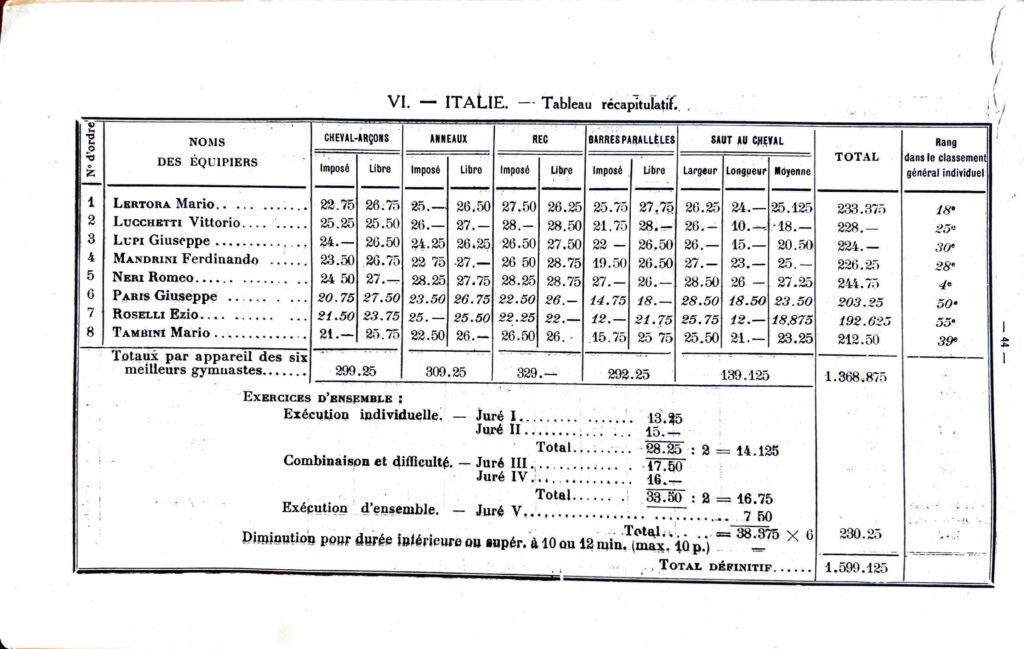
Great Britain
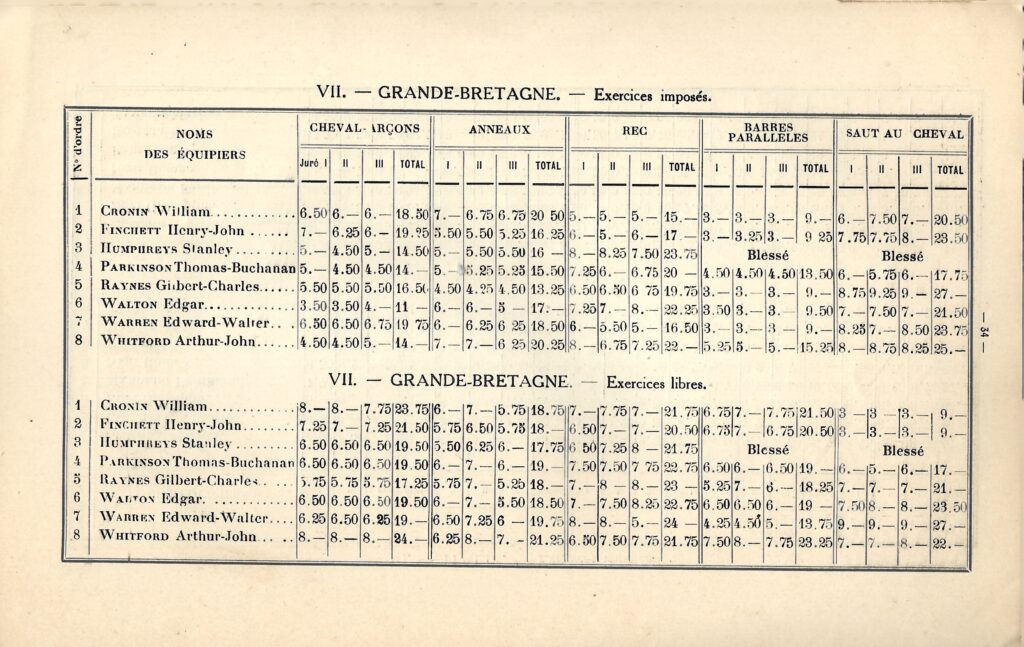
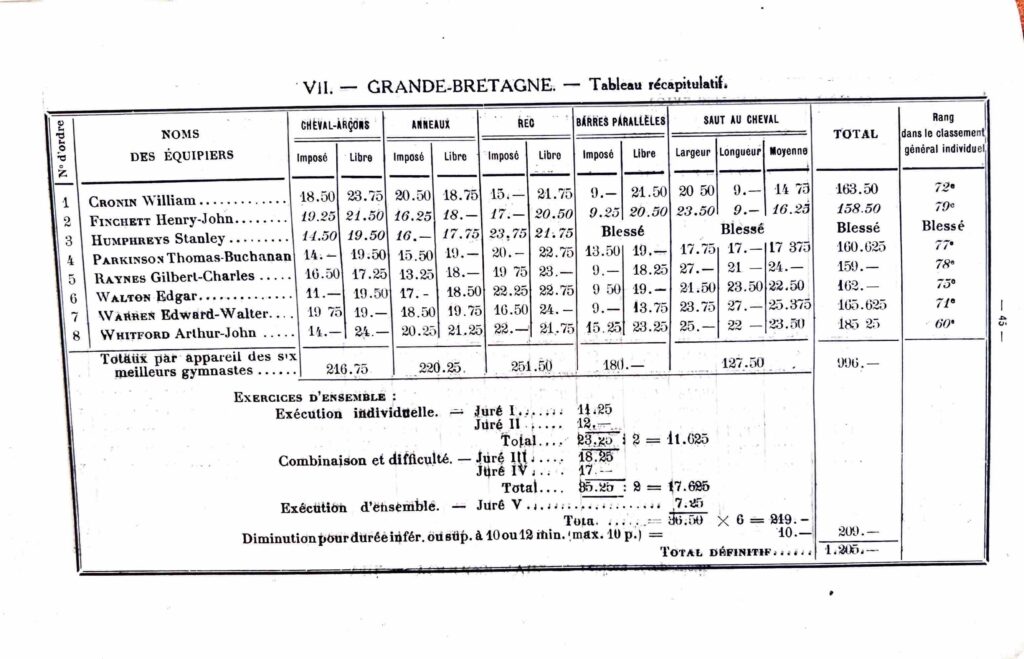
Yugoslavia
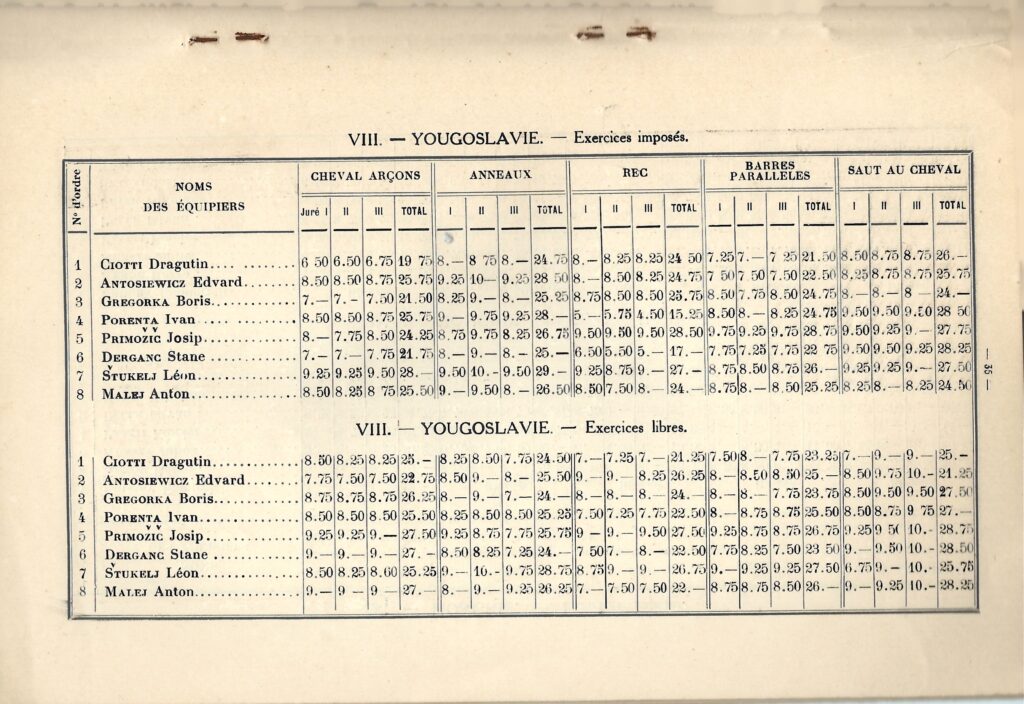
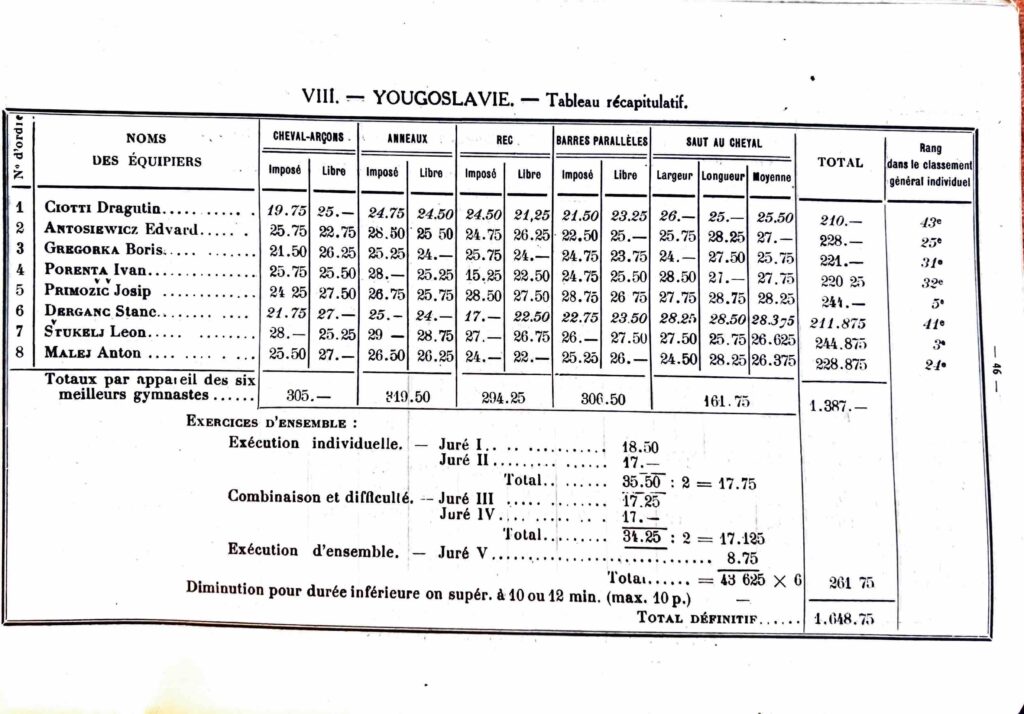
Hungary
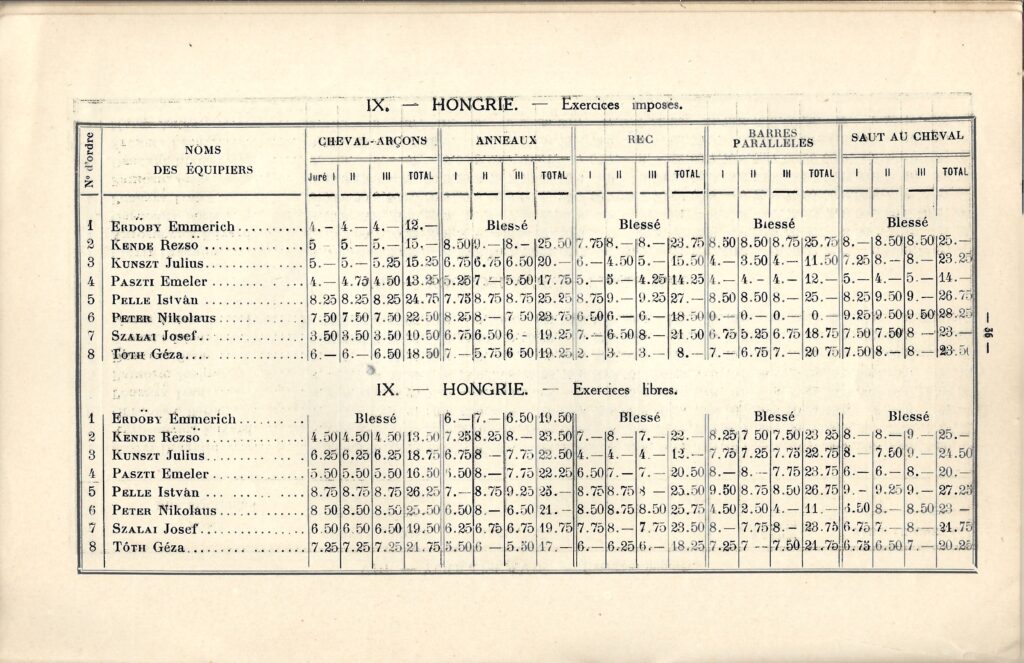
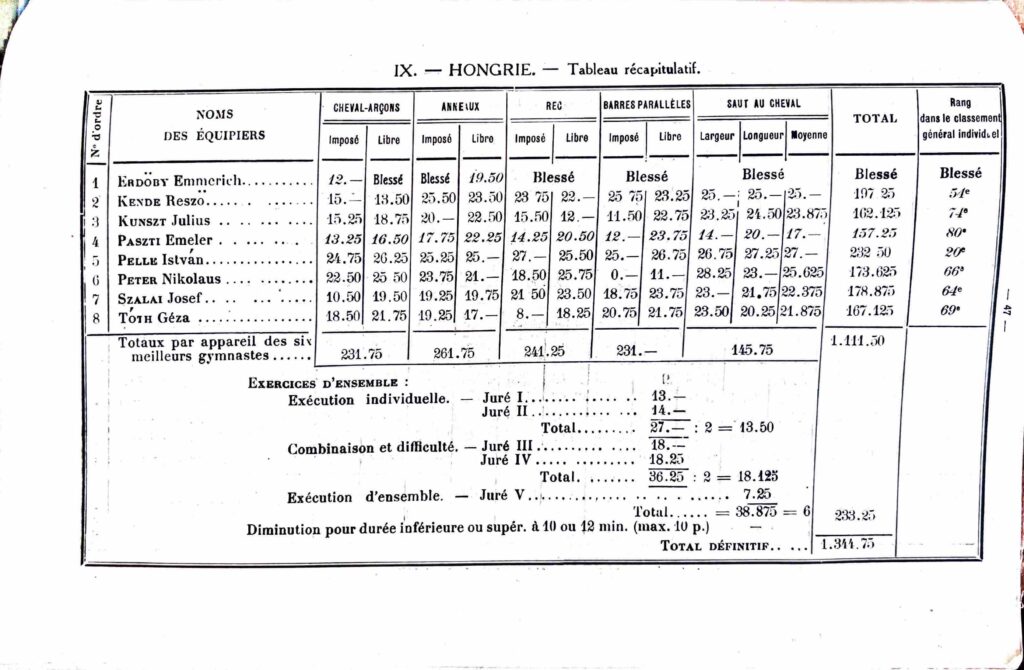
Czechoslovakia
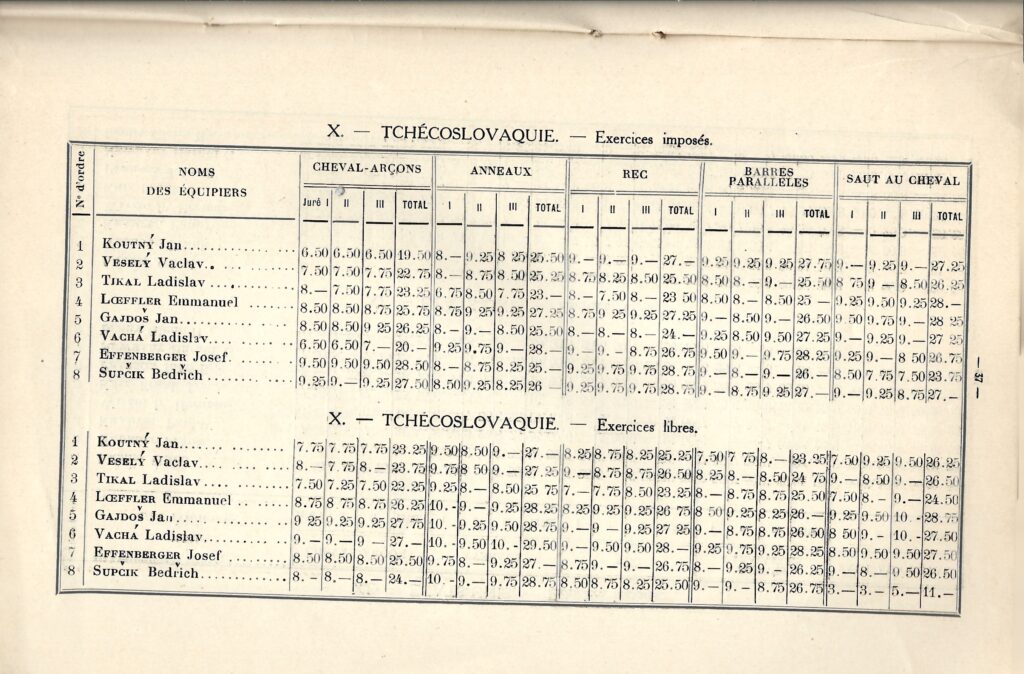
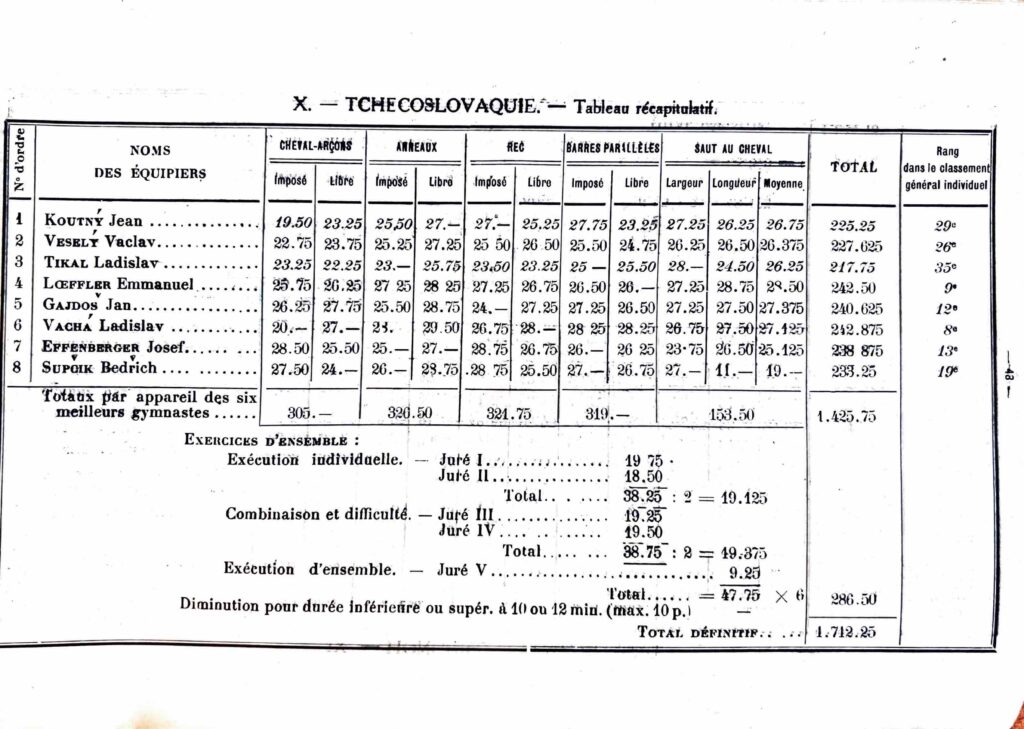
United States
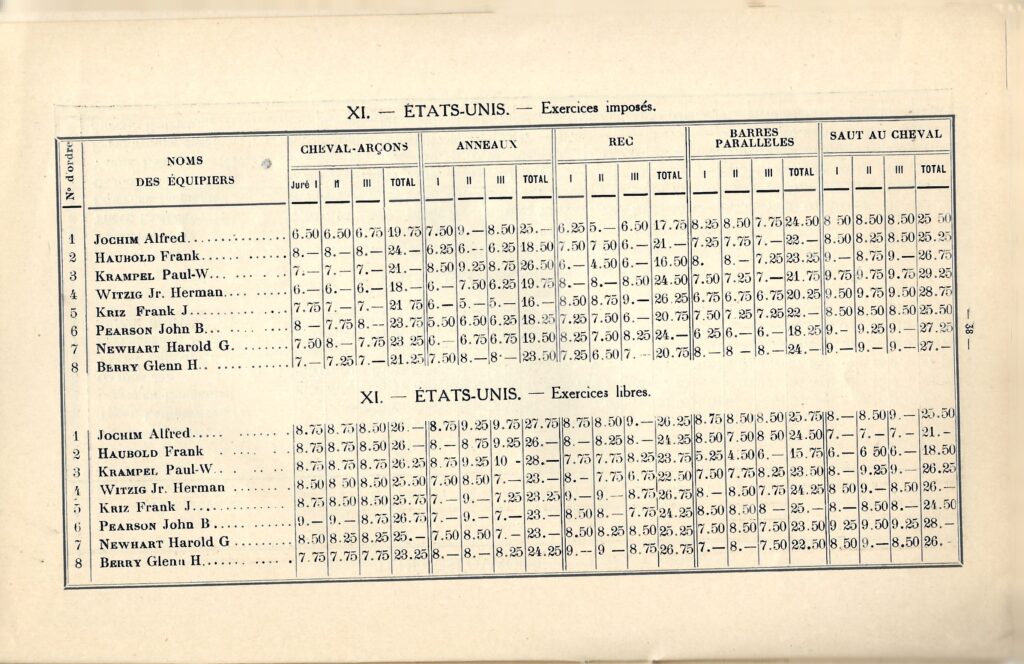
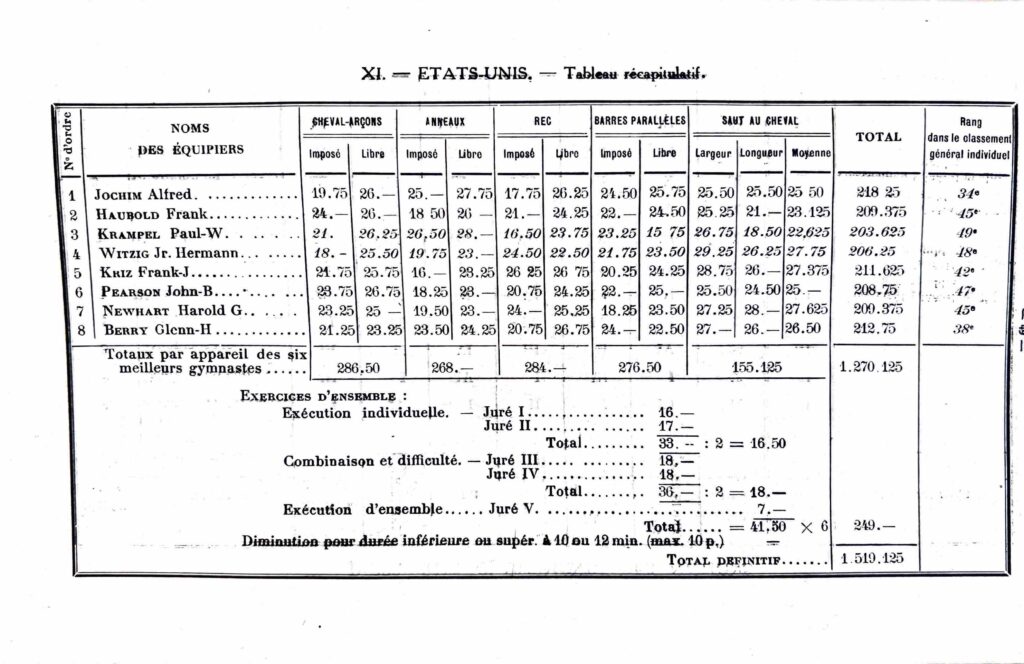
Every Score from Every Judge during the Women’s Competition
Here were the judges for each portion of the competition. It’s interesting that there were only two female judges: Olga Bonaretti (Italy) and Sophie Gurtlerova (Czechoslovakia).
As was the case with the men’s competition, you have to match the roman numerals to the columns in the tables below.
Ensemble Exercises
I. W. Boer (Netherlands)
II. Olga Bonaretti (Italy)
III. Leonard C. Quartly (Great Britain)
IV. Nicolas Bely (Hungary)
V. Edouard Bougouin (France)
VI. Dr. Adolf Picker (United States)
Apparatus Exercises (Engins)
I. J. Zeeman (Netherlands)
II. Colonel Cesare Tifi (Italy)
III. H. C. Cullingham (Great Britain)
IV. Nicolas Bely (Hungary)
V. Edouard Bougouin (France)
VI. Sophie Gurtlerova (Czechoslovakia)
Vaults (Sauts)
I. C. J. Hage (Netherlands)
II. Colonel Cesare Tifi (Italy)
III. Charles J. West (Great Britain)
IV. Nicolas Bely (Hungary)
V. Edouard Bougouin (France)
VI. Dr. Adolf Picker (United States)
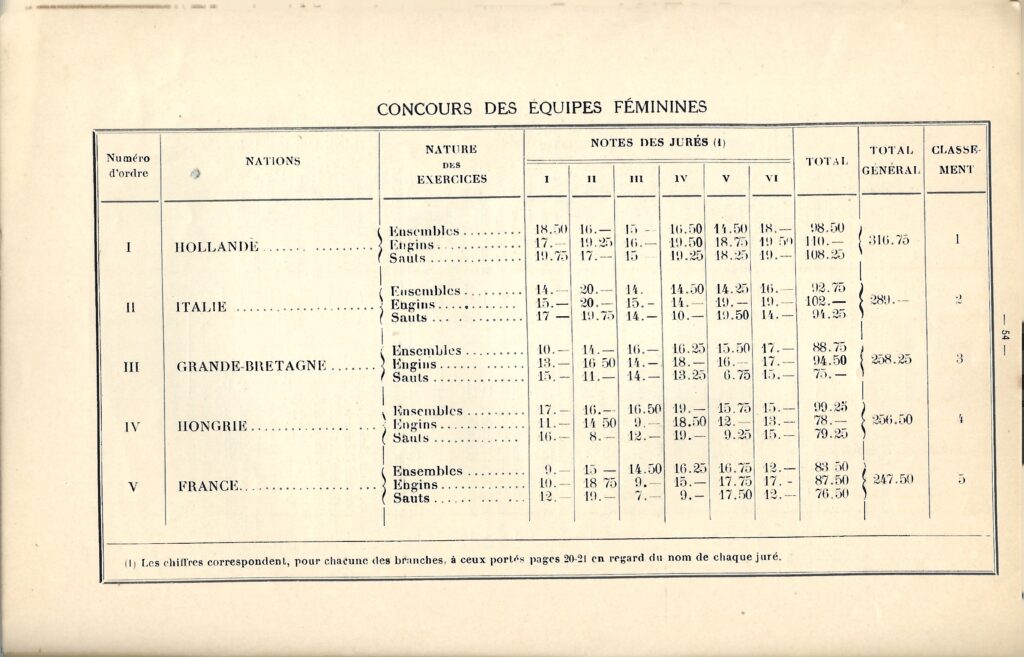
My thought bubble: Nationalistic judging was quite evident. For example, the Italian judges (column II) gave the Italian team the highest scores of the entire competition. On top of that, the scoring was wildly inconsistent. France received a 7 from a British judge and a 19 from an Italian judge on vault.
The Jury of Appeal
Charles Cazalet, President of the FIG
Colonel Huguenin, President of the Jury
Marco Cappelli, Vice President of the Jury
J. H. F. Sommer, Technical Director
